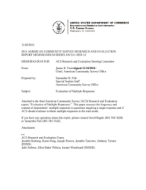
An official website of the United States government
Here’s how you know
Official websites use .gov
A .gov website belongs to an official government organization in the United States.
Secure .gov websites use HTTPS
A lock (
) or https:// means you’ve safely connected to the .gov website. Share sensitive information only on official, secure websites.
-
//
- Census.gov /
- Library /
- Census Working Papers /
- Evaluation of Multiple Responses
Evaluation of Multiple Responses
Evaluation of Multiple Responses
Prior to summer 2007, the Key from Paper (KFP) data capture methodology being used to record data from mailed back questionnaires did not accommodate the capture of multiple checkbox responses for items requesting a single response. For most items on the questionnaire, the keying procedures instructed the keyers to key only the first response in the event of a multiple response. This potentially biased the data by allowing the order of the response categories to dictate which response was chosen. Then, in summer 2007, the American Community Survey (ACS) moved to the Integrated Computer Assisted Data Entry (iCADE) data capture system which uses optical mark recognition to capture all checkbox responses and clerically verifies all instances of multiple responses for each item. Since the new system permits the identification of multiple responses, changes were made to the rules dealing with them to eliminate bias. For most questionnaire items where multiple responses are not acceptable, the response is recorded as missing and later imputed without regard to the multiple responses. However, the instances of multiple responses are available for research purposes. Since the implementation of the iCADE system, the treatment of multiple responses as missing data for questions that require a single response has not been reconsidered. The current methodology was never meant to be the final solution in dealing with multiple responses; it was a less biased approach than the old one and the best that ACS could manage in a time of many new changes. After the 2005 ACS Key from Image (KFI) Test, when multiple response combinations were last studied, it was suggested that for items with high rates of multiple responses we should analyze the multiple response combinations for a possible redesign of the edits. Now that we conveniently have records of multiple responses, we can assess the degree to which blanking occurs in the mail mode and to evaluate what, if any, changes should be made to the capture and processing methods dealing with these responses. This research paper measures the rate at which multiple responses are received in the mail mode for questions that require a single response. For those with a high rate of multiple responses, the response combinations are identified and conjectures are made as to why these mail mode respondents are marking their answers this way.
Others in Series
Working Paper
Working Paper
Working Paper
Share
Some content on this site is available in several different electronic formats. Some of the files may require a plug-in or additional software to view.
 Yes
Yes
 No
NoComments or suggestions?


Top

